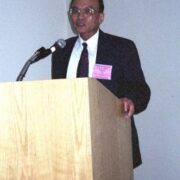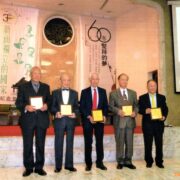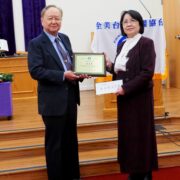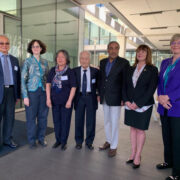Apricot Forest Memoirs of A Retired Doctor
Min-Hsiung Ko, FAAFP, FCAP
Chapter 1
My name is Dr. Min-Hsiung Ko. I am a first class graduate of TMU-1966 (Taipei Medical University), a family physician who came to the United States from Taiwan and practiced medicine here for several decades and now retired living in Philadelphia.
I recently shared my article “Apricot Forest Memoirs/ Professor Huang and I,” which appeared in the book “Last Lecture from Prof. Huang” (recently published by Taipei Medical Universty) with Taiwanese American Archives. The Archives editor suggested that I write some small stories about myself. I’ve done so and published an article in the “Taiwanese American Archives,” “Pacific Times” as well as posting on the Facebook in a Mandarin version.
Recently I saw a Facebook comment from a friend, Professor Daniel Yeh saying that he liked reading my memoir and that not everyone reads Mandarin and asked if I will also come out with an English version. I replied that I’d try and follow Luann Cahn’s advice of daring oneself of doing something new and exciting once in a while, if not every day.
So I’ll start chapter 1 with a short story of “Apricot Forest.” In China, Taiwan, and Japan it represents the medical profession.
So how did “apricot forest” come to represent the medical profession?
“Xinglin” (杏林”apricot forest”) comes from the story of Dong Feng.
Dong Feng was a famous Soochow doctor at the end of the Eastern Han Dynasty and the Three Kingdoms. He was a medical doctor who was skilled in restoring his patients to youthful vigor and appearance and was known for his noble medical ethics.
Dong Feng went to seclusion in Lushan. He lived in the mountains and did not farm. He treated sickness every day. After he cured seriously ill people, it was customary for the patient to plant five apricot trees on his property as payment for his medical services. If the patient required less care, after treatment, the patient planted only one apricot tree as payment. After a few years, the doctor became the owner of more than 100,000 trees, a lush apricot grove.
When the apricots were ripe, Dong Feng built a warehouse in the apricot grove. He informed people that anyone who needed apricots could just bring in a small can of cereal in exchange for a bag of apricots.
Every year, Dong Feng’s apricots were all used to relieve the needs of poor people and provided them with travel expenses for those did not have fares for tolls. Dong Feng lived to be more than 300 years old. When he died his appearance still looked like a 30-year-old man.
Dong Feng had superb medical skills but not fame and fortune. Everybody admired and praised his noble medical ethics. Therefore, “Xinglin,” translated as “Apricot Forest”, has since represented the medical profession.
Chapter 2
I was born on October 12, 1940, in a family-owned Department Store in Fengyuan, Taiwan. Mom said I was delivered by a Japanese midwife who preserved a small piece of umbilical cord and placed it in a small box as a keepsake of my birth.
This story reminds me of my medical school Dean, Dr. Chien-Tien Hsu, an OB/GYN doctor who once told us personally in class that he was delivered by an elderly countryside woman using a pair of rusty scissors to cut off the umbilical cord.
I also remembered when I was a second-year medical resident physician at Veterans General Hospital in Taipei, Dean Hsu was a distinguished guest at my wedding party. He delivered his congratulatory speech and offered bride Lih-Ay best wishes of bearing many descendants. He said he was an obstetrician and certainly could be of big help; if pregnant with one baby, he would deliver one, with two, he would deliver two, he said he could handle even dozens with no problem at all. The entire guest audience burst into spontaneous cachinnation and the atmosphere was joyous and light.
When I was born, Taiwan was still in the era of Japanese occupation and World War II was still going on rampantly. Allied planes often bombarded Taiwan. Every household needed to dig a hole outside the house as an anti-aircraft shelter. I still remembered as a small child, whenever the air raid alarm sounded, my mom would quickly hurry her children into the shelter and awaited “Tai-Hee” (lifting of alarm).
I still recalled one time my baby sister (then about 3 years old), Merry fell into a ditch in front of the store. Luckily two men, one patriotic lottery tickets vendor and the other, a fountain pen seller, pulled her up as soon as they could. If not soon enough, she would have been pushed by the flowing ditch water into the unreachable dark cement-covered part of the ditch and very likely would have drowned. They handed the little girl to my father. At first, my father did not recognize his daughter, holding a wet, dirty-faced little girl asking around whose girl she was. Later, my mother prepared two meals comprised of pig feet, noodles, sausage, and pork liver to give to the two good Samaritan uncles in appreciation for their serendipitous arrival and life-saving intervention.
Chapter 3
In 1947, I was seven years old and entered the Fengyuan Elementary School. I still vaguely remembered my grandmother talking about the incident on February 28 (228 events.) I remembered one time we “wild children” ran to a creek, playing and swimming, was discovered by my grandmother, and I was rightly scolded by Grandma- she was so worried about I might drown in the creek.
On March 5, 1953, during my 6th year in elementary school, I still remembered that many students running around the campus spreading the big news of “Big Devil” Stalin’s sudden death in Russia. I could also recall the scenes of our artist principal, Mr. Yeh, teaching his pupils how to draw a landscape in the school campus. He always praised the talented artists and encouraged and showed the others to do a better job composing.
When I was thirteen, I graduated from elementary school and passed the entrance examinations of two middle schools: namely Taichung First Middle School and Taichung Junior High Commercial School. On the day of registration, I had a dilemma over which school to attend. Daddy was a businessman and wanted me to attend commercial school, but I preferred Taichung First Middle School. Finally, Daddy concurred and let me have my wish. I spent 3 years in this Junior High School. I could recall going to Dr. Sun Yet-Sen’s Park often and do an early study in the Park Lake Pavilion. Due to my high marks, I was privileged to advance to the Senior High School with no need for additional entrance examinations.
During my high school days, Joint College Entrance Exam was ongoing in Taiwan. The competition to gain admittance into prestigious universities with popular fields of study was fierce. Everybody hoped to pass the exam and get admitted to their dream schools and fields of study. Most students studied very hard and conscientiously. Very few were idle, wandering and fooling around.
My grades were good, especially English. One time my English teacher Chi, Bang-Yuan gave us a quiz in class. She asked: How do you say” 毛毛雨” in English? For a minute, no one spoke. I gently whispered, “drizzle,” from the front row. Teacher Chi heard my answer and commended me for it.
Many years later, in the United States, I saw teacher Chi wrote and published a book called “The Giant Flow River.” Once I heard about the book, I went to World Bookstore in Philadelphia to buy my own copy. Within a few days, I finished reading the entire book. It was a book I enjoyed reading it greatly. She wrote engagingly about her personal experiences during the era of misery and nostalgia. She also mentioned and described her teaching experience at Taichung First High School and my high school classmate, lawyer Liao Yi-Nan.
This certainly reminded me of some more high school memories.
One year during the summer vacation, Physical Education Teacher Mr. Lin, Shaoxi took several high school students to Dongpu for rock climbing and Sun Moon Lake for water frolic and swimming. We rented a boat for Teacher Lin to escort us. We then took a long distance swim from the lake shore all the way to the mid-lake Big Kwang-Hua Island. When we finally reached the island shore and got on shore, we were all short-winded and exhausted. After sufficient recovery time, clad in only swim trunks, we walked the souvenir and food streets feeling happy-go-lucky.
Many years ago, a big Taiwan earthquake sank most of Kwang-Hua Island to the bottom of the lake leaving only a tiny bit of land sticking out the lake water we see today. Powerful natural forces changed the topography we once knew.
Chapter 4
After graduating from high school in 1959, I was admitted to the Department of Electrical Engineering at Cheng Kung University in Tainan. I studied there for one year. It was nice learning some engineering related topics such as mechanical drawing and machine workshop. I always aspired to become a doctor, so I decided to try again and took the Joint College Entrance Exam once more. Luckily this time I was able to gain admittance to Taipei Medical College in 1960. In 1965, I started a year of rotating internship at the 801 Army General Hospital (now Tri-Service General Hospital) and finished and graduated in 1966.
I was then enlisted in the ROC Navy and was assigned to a Landing Ship Tank (LST-228) naval ship as an Ensign Medical Officer, cruising and patrolling the Taiwan Strait. I was told the ship can accommodate 19 tanks. After landing when the tide receded, it just sits on the beach, a beached whale. To return to the ocean, it was necessary to wait for high tide. On many occasions, amid Communist China’s “Odd day bombardment, even day cease-fire” predicament, my ship carried out many beach landing and supply missions to Kinmen Island.
I really enjoyed the feeling of sitting in the captain’s seat on the bridge looking at the vast ocean and feeling the wind and white waves and commanding the entire ship when I was on cruise duty. Occasionally there will be very tense moments. If any suspicious enemy ships were sighted in the distant sea through detection binoculars, I would need to declare “Combat Readiness.” The gunslingers were all in place and the officers’ dining table was immediately transformed into an operating table.
Fortunately, every time it was like “I aim at you, you aim at me.” Each side is ready if the other fires first; the two ships passing each other cautiously albeit, it racked our nerves.
I remembered once National Defense minister Chiang, Ching-Kuo came aboard our ship for an inspection visit and visited my clinic too. Captain Zheng, Zhan-tang introduced me to the minister, saying that Medical Officer Dr. Ko graduated from Taipei Medical College. I held a hand salute to the minister. He also smiled, nodding his approval.
I was honorably discharged from the Navy in 1967. I then trained for three years at the Department of Internal Medicine as a resident doctor at Taipei Veterans General Hospital. I remembered Mr. Lu, Zhide was the hospital president and, Professor Ding, Nong was the director of the Department of Internal Medicine then. He needed some model English medical records as teaching aids for some senior medical students and interns of National Defense Medical School.
We just admitted a new patient, a 90+ -year-old Mr. Zhao, Heng -Ti for a checkup. I heard that this distinguished old gentleman was the uncle of Minister Mr. Zhao, Ju-Yu, Retired officers/soldiers counseling committee chairman. He wrote the Title on Master Chang, Ta-Chen’s great masterpiece “Picture of Ten-Thousand-Miles Long River.” His old medical record was voluminous with more than 10 times of old admission records. I spent a lot of time writing English summaries of each admission. Professor Ting seemed very pleased and highly praised my English. He then assigned me to take these would-be doctors for a hospital teaching round.
In 1970, several specialist physicians of the General Internal Medicine Department voted to elect a Chief Resident Physician. A senior Dr. Chen Jian-keng was elected. I congratulated him. I only got one vote from Dr. Jiang, Bi-Ning, who just returned to Taiwan from the United States. Not able to be promoted to chief resident, I decided to further my study and training in the United States.
I came to the United States in 1970, stopped over Tokyo, Japan, and visited my uncle Dr. Ko, Dong-Liang, a practicing obstetrician/gynecologist at Ikebukuro, Tokyo. He also asked one of his office assistants, a pretty Japanese lady to accompany me for a one-day sightseeing Tokyo tour. We also enjoyed a classic drama in Ginza. I also made a special trip to Osaka to visit the 1970 World’s Fair. I saw many interesting pavilions, especially those of Russia, America, England, and Japan.
My first stop in the United States was Chicago, where my cousin Dr. Ko, Song-Tao picked me up at O’Hare Airport. He was a surgical resident doctor at Grant Hospital, a graduate of Kaohsiung Medical College. He took me to visit his hospital and dormitory. He also took me and a few friends to see a strip show that Taiwan did not have. He obviously wanted me to be well entertained and more informed about a new country.
Chapter 5
In August 1970, upon arrival in Barberton, Ohio, I interned for one year at Barberton Citizens Hospital. The hospital house staff coordinator, Mrs. Helen Young was very kind to us interns. She took very good care of us interns, who were mostly from abroad. She taught us many American customs and conducted English class for interns and their wives to improve their English. She has long since passed away, but to this day, many of us still missed her dearly. I later moved to Pennsylvania and received 2 years of surgical training at Robert Packer Hospital/Guthrie Clinic in Sayre, Pennsylvania.
I came to Philadelphia in 1973 and received four years of clinical and anatomical pathology training at Medical College of Pennsylvania (now Drexel University). I have conducted more than 100 autopsies. Former director of pathology, Dr. Dubin was my guiding professor. He was the one who described and published “Dubin Johnson Syndrome.” He was very knowledgeable, kind and humorous, and was recognized as a world authority of liver pathology. He also cared very much about medical students, interns and residents and his subordinates. He spared no effort in guiding the younger generations. He reminds me of our beloved TMU’s pathology professor Dr. TS Huang.
Dr. Dubin gave me an autographed pathology atlas as a gift and asked me to study it well. One time, as he oversaw me very skillfully performing an autopsy in front of a crowd of medical students, interns, residents and clinicians, he highly praised my technique and skill and jokingly told everybody that if necessary he would prefer me to remove his appendix.
As a result of my hard work on theoretical knowledge and my wealth of clinical experience, I later passed board exams of clinical pathology (including clinical chemistry, microbiology, blood bank, hematology and laboratory diagnosis ) and anatomical pathology (including surgical pathology, cytopathology, immunology, and electronic microscopic pathology etc.) and was elected Fellow of College of American Pathologists and a Biographee of Marquis Who’s Who.
I worked as a pathologist for several years at both St. Mary’s Hospitals in Philadelphia and Langhorne and also became a visiting assistant professor at Medical College of Pennsylvania (now Drexel University) and Thomas Jefferson University handling and juggling hospital practice, research and teaching at the same time.
In 1981, I spent a year as Deputy Director of Emergency Department at St Mary’s Hospital in Philadelphia and also was moonlighting at Nazareth Hospital and Germantown Hospital treating many acute, chronic and critically ill patients. As the law and order in the vicinity of the hospitals were not very good, every day I had to cope with many gunshot wounds, knife wound injuries, fractures, dislocations, bleeding … trauma patients and also heart attacks, strokes or even medical patients with the flu. In case of lack of support from the on-call specialists, I would often be forced to do emergency treatment unassisted. I stitched a lot of trauma in the emergency room and personally restored the dislocated shoulders of several patients. Besides treating live patients, sometimes I needed to deal with corpses too. I remembered one time several Philadelphia police officers brought in a very bloody explosion victim with half of his head already blown away which clearly belonged to coroner’s office and morgue, not ER. The police only wanted the convenience of quickly obtaining a death certificate.
As a pathologist, I also worked part-time in several prisons in Philadelphia. Prisoners also have some recreational activities like boxing, and I also became a ringside physician.
Anyone who is injured during the competition needs to be urgently dealt with and assessed for injuries. If necessary, I have the right to suspend and stop the boxing match. One afternoon, the pugilists landed blows, one of which resulted in a severe nosebleed. I stopped the fight and treated the injured. Down there the prisoners were very impatient and were chanting “Go! Go! Go!” Initially, the nosebleed was hard to control and I considered canceling the bout and let prisoners go back to their beds. But ,with their emotions running so high, I thought, if I suspend the match, they would become even more hostile. Fortunately, after a while nosebleed stopped, this boxer looked okay. I announced: continue the competition, there was sudden thunderous applause and everyone was so excited, obviously, all preferred live boxing over television.
Another terrible jail experience. Many years ago (October 28, 1989) at Holmsberg prison in Philadelphia, there was a prisoner major riot. 120 prisoners blocked the cells with cushions and other debris and took hostages. They had hand-made weapons. The guards carried batons and shields, no guns, and the government dispatched a large number of guards into the prison to suppress the riot.
Fortunately, I was not on duty that day. I went to work the next day. The entire prison gymnasium was full of wounded people, waiting for first aid and follow-up treatment. This scene reminded me of a scene in the movie “Gone with the Wind” where a military doctor was treating many wounded soldiers and civilians lying everywhere in the Battle of Atlanta.
Chapter 6
After years of hard work, I have accumulated a wealth of theoretical knowledge and clinical experience. In order to better serve the sick, I decided to return to private practice in clinical medicine.
I became a general family doctor. I practiced medicine for thirty years in the Greater Philadelphia and Buck County areas. During this period I was also elected Fellow, American Academy of Family Physicians (FAAFP.) I practiced family medicine until 2012 when I retired.
For several decades, I’ve treated, alleviated and cured many patients. Being able to alleviate patients’ sufferings was my biggest pleasure and rewards. Some patients were quite memorable.
For example, once when I was on duty at Veterans General Hospital Emergency Room, a middle-aged man was referred to us from National Taiwan University Hospital. He vomited bright red blood ceaselessly. No one could find the source of bleeding. All kinds of X-ray had been taken elsewhere and a lot of other tests without any positive findings. The esophagus, stomach, duodenum, small intestine, large intestine were examined and everything was normal. No ulcers, no cancers were evident. No cirrhosis of the liver with rupture of esophageal varices was found.
I also did a routine examination of this patient from head to toe, with no abnormalities seen initially. However, he was still terribly worried, anxious and spitting up bright red blood continuously.
Later, I played a stomatologist, I asked the patient to thoroughly rinse his mouth and gargle many times. I then used a few pieces of clean gauze to clean all the teeth, gums, tongue and oral mucosa.
Lo and behold, I noticed the source of bleeding in the gum of upper jaw. A tiny artery there ruptured and was gushing bright red blood ceaselessly. It was hidden by the upper lip and was hard to find. The bleeding was hard to stop by pressure alone. I summoned an on-call oral surgeon to the emergency room. He easily stopped the bleeding by cauterization and small suture. Needless to say, this patient was very thankful and very happy upon discharge from the emergency room.
Chapter 7
Another case of successful treatment of Alzheimer’s disease-like senile dementia.
An elderly Indian man, who at first was healthy and gradually became demented later. His son told me that his father did not even know when he was eating -where to put food in his mouth, he just stuffed the food into his nose.
Many people think that Alzheimer’s disease or other dementia is progressive without a cure. It should be considered for some special reasons, such as head trauma caused by subdural hemorrhage with blood clots pressing the brain or vitamin B12 deficiency. This kind of dementia is reversible and may be cured by surgery or some injections. I gave this old man a blood test and found a serious vitamin B12 deficiency. I gave him a few B12 injections and he responded and gradually recovered and returned to normal. A few years later I was privileged to attend his 80th birthday party.
In addition, I had another memorable experience. A Taiwanese middle-aged woman with benign uterine fibroids (leiomyoma,) I gave her a regular ultrasound examination, the purpose was just to assess the uterine fibroids to see if they became larger. It unexpectedly found an ovarian tumor. I quickly consulted a gynecologist.
She immediately did a total oophosalpingohysterectomy. She told me she found a big cystic ovarian cancer which was later confirmed to be ovarian cyst-adenocarcinoma pathologically. The cystic wall was smooth, shining and extremely thin on the verge of rupture. She said that this patient was really lucky, a bit delay in diagnosis and surgery, the cystic cancer tumor would have ruptured allowing numerous cancer cells scurrying around in her pelvic cavity. The gynecologic surgeon was able to carefully and completely remove the entire uterus, Fallopian tubes, cancerous ovaries en masse. Today, more than 10 years after surgery, this patient is still enjoying her life healthily and happily.
Chapter 8
Another unusual case.
A 17-year-old Indian lad suffered chills, fever, and general malaise. He was initially seen elsewhere and the cause of fever was not known. Several antibiotics had been tried without effect.
He came to my office. I did a thorough history and physical without many clues. Initial CBC only showed mild anemia and leukocytosis. Further history, including travel history, revealed that not long ago he traveled with his parents back to an Indian small village for home and relatives visit. He did have some contacts with chill and fever patients and suffered many mosquito bites.
This gave me a lead so I ordered a blood test looking for Plasmodium (malaria protozoa) in the red blood cells. The lab techs told me they never got such strange lab requests before but they still dutifully did the test anyway. They were excited that they did find malaria parasite in the red blood cells, that was very unusual in the United States. I then prescribed some anti-malaria medications. This Indian lad responded quickly and the chills and fever subsided in no time. He was also happily discharged.
A recent story of growing mushroom in the stomach reminds me of treating yet another unusual patient many years ago i.e. A “zoo” in the ear. A middle-aged man came in ER complaining of hearing thunderous noise and aching pain in one side of his face. The initial quick checkup was unremarkable and he appeared very restless and anxious. I then used an ophthalmo-otoscope and looked inside his ears. Lo and behold, I discovered a live baby roach inside his left external auditory canal. This trapped little creature kept scratching on the tympanic membrane ( eardrum) ceaselessly and struggled to get out. I managed to remove this baby alive and the patient immediately felt well. Can’t remember whether I pardoned this baby roach or killed it.
Chapter 9
I graduated from the first class of 1966 Taipei Medical University. I served as president of Philadelphia Chapter of the Taipei Medical University Alumni Association for two years and president of Philadelphia Chapter of the North American Taiwanese Medical Association (NATMA) for 8 years.
I won a Buck County Community Service Award, a Distinguished Service Award from Veterans General Hospital, a “Project Award” from American Cancer Society (ACS) for Taiwanese American Community’s Awareness. Prevention and Treatment of Breast Cancer, Colorectal Cancer, and Liver cancer and many “Physician Recognition Awards” from the American Medical Association (AMA). I also received an award from North American Taiwanese Medical Association (NATMA) for exemplary service as President of Philadelphia Chapter and a “Certificate of Excellence” award from Blue Cross Blue Shield and a ” Biographee Certificate” from Marquis Who’s Who.
Chapter 10 (Final)
In April, 2016, I hosted a TMU-1966 50-year graduation class reunion at Taipei Medical University and around the island tour in Taiwan. In Octob,2016, I also attended North American Taiwanese Medical Association’s annual convention in Las Vegas and a post-convention National Parks tour. We all enjoyed visiting many magnificent canyons and breathtaking national scenic wonders. In August, 2017, I went with few friends and family to Seattle, Vancouver and visited the great Rocky mountains and enjoyed taking the gigantic ” ice and snow van” ride to see the great and beautiful Great Glacier.
After retirement, I volunteered occasionally to help the American Cancer Society (ACS) as a lecturer to advocate for awareness, prevention, and treatment of various cancers and hepatitis. My wife Lih-Ay also occasionally helped out as volunteer, binding and distributing health and cancer prevention information to everyone.
Philadelphia is a historic city with many interesting places to visit. There are five medical schools. Two of the nation’s twenty best hospitals, are in Philadelphia: the University of Pennsylvania Hospital and the Jefferson University Hospital. There are also art galleries, concert halls, theaters, museums of natural sciences, U. S. Mint, Constitution Center, Independence Hall, parks, libraries, stadiums, various museums, circus school, juggling club, swimming pools, City Hall, Observatory and more.
I really enjoyed the excitement of recently embarking on the Observatory and watching the Saturn with its ring system thru the gigantic astronomical telescope. There are many gourmet restaurants. My son Jay, a University of Pennsylvania graduate working on IT job is president of Philadelphia Jugglers’ Club. I sometimes go to the club to practice juggling. I also enjoy going to LA Fitness Club to work out, swim, and practice my favorite tricks: Shirsha-asana (Headstand,) underwater single handstand, handwalk, and mermaid maneuver. I also practice some Tai Chi and Yoga.
Recently a friend from my same hometown, Fengyuan, Ms. Kylie Tsai, invited and drove my son Jimmy and me to see a live Chinese brush painting master, Ms. Josephine C Tsai’s live painting demo and her students’ art exhibit. We also went to see the Asian Film Festival. My daughter, Gloria, just congratulated me from California on FaceTime for my 77th birthday.
I really enjoy my fulfilling and happy life here in the Philadelphia area after my retirement.
(10/12/2017), Philadelphia
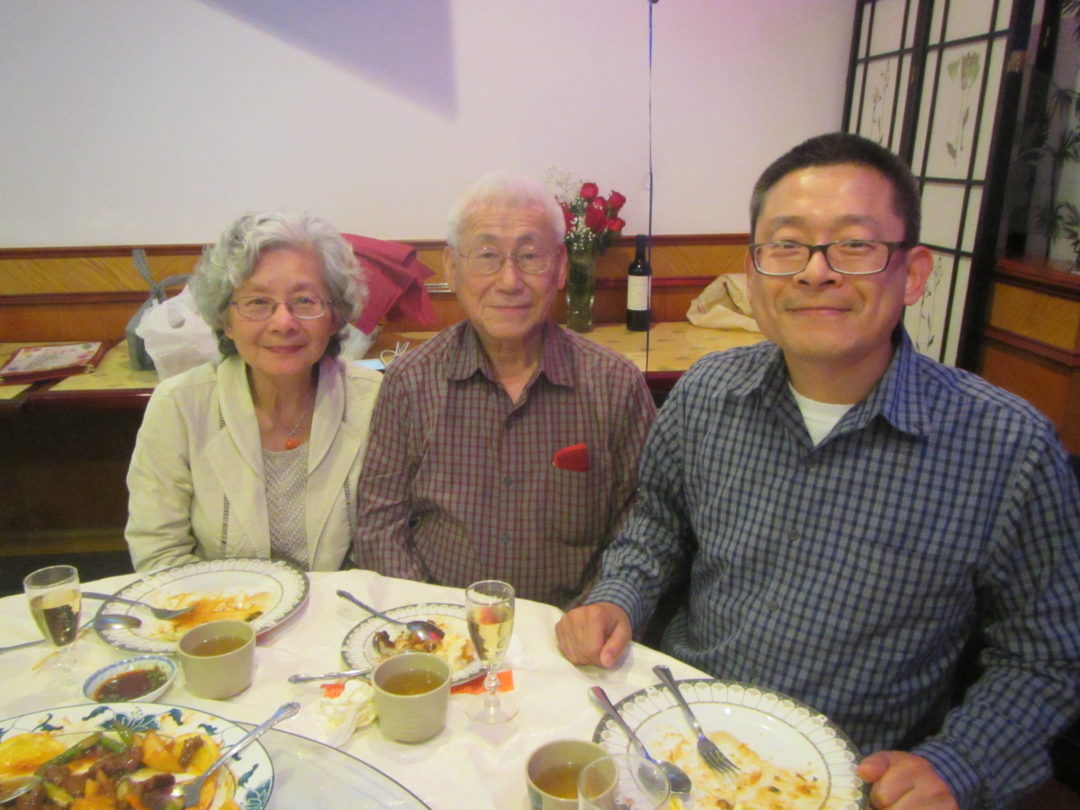
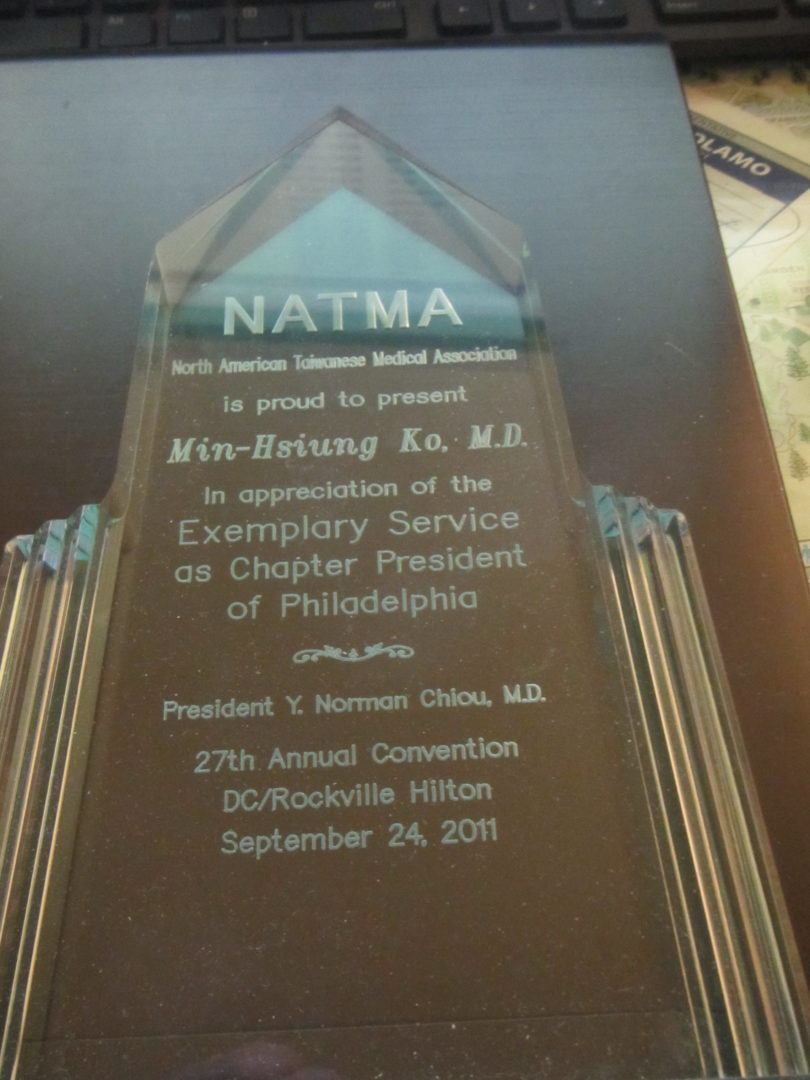
Source from Dr. M. Ko 01/2019
Posted in 01/2019

